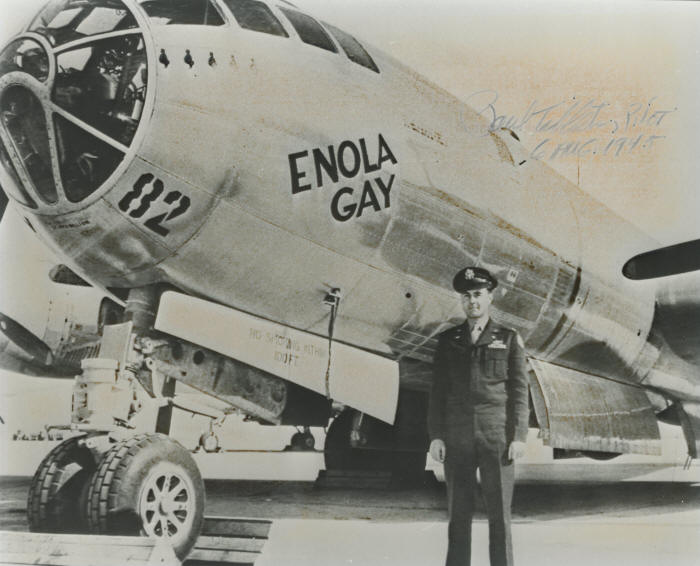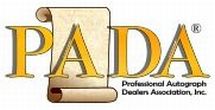1504601
[World War II — Atomic Bomb — Hiroshima]
Paul W. Tibbets
Scroll down to see images of the item below the description
Paul Warfield Tibbets, Jr., 1915–2007. 8" x 10" black-and-white photograph of Tibbets standing in front of the Enola Gay, signed Paul Tibbets, Pilot / 6 Aug. 1945.
Tibbets piloted the Enola Gay, a modified B29 Stratofortress, in the flight to drop the first atomic bomb ever used in war. The airplane was named after Tibbets's mother, who was Enola Gay Haggard before her marriage.
The flight culminated months of work that Tibbets, then a lieutenant colonel, had done to help prepare for the atomic bomb. In September 1944, the director of the Manhattan Project, the secret American project to develop the bomb, gave Tibbets, whom Army Air Force chief General Henry H. Arnold called the "best damned pilot in the Air Force," the responsibility of organizing and training a team to deliver the bomb in combat operations. He also instructed Tibbets to determine and supervise the modifications necessary to make the B-29 capable of delivering the bomb. Tibbets requisitioned 15 new B-29s and retrofitted them by adding fuel-injected engines, removing much of the armor plating, and reconfiguring the bomb bay. The reconfigured planes could fly higher and faster, beyond the reach of anti-aircraft fire.
At 2:30 a.m. on August 6, 1945, the Enola Gay left Tinian Island, the forward American airbase in the Marianas, for Special Bombing Mission No. 13. In the bomb bay was "Little Boy,” the name given to the first atomic bomb to used in warfare. At 8:16 a.m., ”Little Boy” was dropped on Hiroshima, Japan. The bomb caused massive destruction and sped the end of World War II.
In 1994, responding to criticism of the use of the atomic bomb, Tibbets said:
I am an airman, a pilot. In 1945, I was wearing the uniform of the US Army [Air Forces] following the orders of our commander-in-chief. I was, to the best of my ability, doing what I could to bring the war to a victorious conclusion—just as millions of people were doing here at home and around the world. Each of us—friend and foe alike—were doing the dictates of our respective governments. I recruited, trained and led the members of the 509th Composite Bomb Group. We had a mission. Quite simply, bring about the end of World War II. I feel I was fortunate to have been chosen to command that organization and to lead them into combat. To my knowledge, no other officer has since been accorded the scope of the responsibilities placed on my shoulders at that time.
As for the missions flown against Japan on the 6th and 9th of August, 1945, I would remind you, we were at war. Our job was to win. Once the targets were named and presidential approval received, we were to deliver the weapons as expeditiously as possible consistent with good tactics. The objective was to stop the fighting, thereby saving further loss of life on both sides. The urgency of the situation demanded that we use the weapons first—before the technology could be used against us.
During the course of the half century that has elapsed since the use of the atomic weapons, many scribes have chronicled the flight of the Enola Gay with nothing but descriptions of the destructive nature of our atomic weapons. Few such narratives have been objective. Indeed, I suggest to you that few, if any of the articles, books, films or reports have ever attempted to discuss the missions of August 6th and August 9th, 1945 in the context of the times. Simply stated the Enola Gay and the 509th Composite Bomb Group have been denied a historically correct representation to the public. Most writers have looked to the ashes of Hiroshima and Nagasaki to find answers for the use of those atomic weapons. The real answers lay in thousands of graves from Pearl Harbor around the world to Normandy and back again. The actual use of the weapons as ordered by the President of the United States was believed to be the quickest and least costly (in terms of lives lost) way to stop the killing. I carried out those orders with the loyal support of the men of the 509th Composite Bomb Group and the United States military at large. Our job was to serve. Our sworn duty was to God, country and victory.
Tibbets retired from the Army as a Brigadier General in 1966.
Tibbets has signed this photograph in blue felt-tip pen and has added his title, "Pilot," and the date of his historic flight. The photo has a bit of silvering, and there is a bit of pinkish toning at the upper right behind Tibbetsʼ signature, which is a bit faded, apparently from prior framing. The piece is priced accordingly. Overall it is in fine condition.
Unframed.
Click here to see more World War II items on the American History page.





